Community-Based Cooperatives: A New Business Model for the Development of Italian Inner Areas
Abstract
1. Introduction
- RQ1. What are IAs’ critical issues?
- RQ2. What are the needs of communities living in IAs?
- RQ3. What are the potential business fields for establishing a CBC?
2. Materials and Methods
2.1. Dataset Implementation
2.2. Methodology
3. Results
4. Discussion
5. Conclusions
Author Contributions
Funding
Acknowledgments
Conflicts of Interest
References
- Carlucci, C.; Guerrizio, A.; Lucatelli, S. Nota Metodologica per La Definizione Delle Aree Interne; Agenzia per la coesione territoriale: Roma, Italia, 2012. [Google Scholar]
- Dipartimento per lo Sviluppo e la Coesione Economica (DPS). Strategia Nazionale per le Aree Interne; DPS: Roma, Italy, 2014. Available online: http://www.programmazioneeconomica.gov.it/2019/05/23/strategia-nazionale-delle-aree-interne/ (accessed on 30 January 2020).
- Barca, F. Un progetto per le Aree Interne dell’Italia. In Aree Interne e Progetti d’area; Meloni, B., Ed.; Rosenberg & Sellier: Torino, Italia, 2015; pp. 29–35. [Google Scholar]
- Borzaga, C.; Zandonai, F. Oltre la narrazione, fuori dagli schemi: I processi generativi delle imprese di comunità. Impresa Sociale 2015, 5, 1–7. [Google Scholar]
- Sanna, F.; De Bernardo, V. Sviluppo locale e Cooperazione Sociale. In Beni Comuni, Territorio, Risorse e Potenzialità da Connettere e Rilanciare; Ecra: Roma, Italy, 2015. [Google Scholar]
- UK Gov. Digital Service (Updated 28 March 2017). Community Development Handbook. Available online: https://www.gov.uk/government/publications/community-development-handbook/community-development-handbook (accessed on 30 January 2020).
- Calvaresi, C. Innovazioni dal basso e imprese di comunità: I segnali di futuro delle aree interne. Agriregionieuropa 2016, 45, 31–34. [Google Scholar]
- Carrosio, G. Reti sociali e nuovi abitanti nelle aree rurali marginali. Sci. Territ. 2014, 1, 201–210. [Google Scholar]
- Depedri, S.; Turri, S. Dalla funzione sociale alla cooperativa di comunità: Un caso studio per discutere sul flebile confine. Impresa Soc. 2015, 5, 65–82. [Google Scholar]
- Warren, S.; Jones, P. (Eds.) Creative Economies, Creative Communities. Rethinking Place, Policy and Practice; Ashgate: London, UK, 2015. [Google Scholar]
- Coyle, S.J.; Duany, A. (Eds.) Sustainable and Resilient Communities. A Comprehensive Action Plan for Towns, Cities and Regions; John Wiley & Sons: Hoboken, NJ, USA, 2011. [Google Scholar]
- Colucci, A.; Cottino, P. The shock must go on: Territori e comunità di fronte all’impresa della resilienza sociale. Impresa Soc. 2015, 5, 36–43. [Google Scholar]
- Gibson-Graham, J.; Cameron, J. Community Enterprises: Imagining and enacting alternatives to capitalism. Soc. Altern. 2007, 26, 20–25. [Google Scholar] [CrossRef]
- Mori, P.; Sforzi, J. Imprese di Comunità. Innovazione Istituzionale; Partecipazione e Sviluppo Locale; Il Mulino: Bologna, Italia, 2019. [Google Scholar]
- Ramonjavelo, V.; Préfontaine, L.; Skander, D.; Ricard, L. Une assise au développement des PPP: La confiance institutionnelle, interorganisationnelle et interpersonnelle. Can. Public Adm. 2006, 49, 350–374. [Google Scholar] [CrossRef]
- Sacranie, H. Hybridity in a Large English Housing Association: A Tale of Strategy, Culture and Community Investment. Hous. Stud. 2012, 27, 533–552. [Google Scholar] [CrossRef]
- Pache, A.C.; Santos, F. Inside the Hybrid Organization: Selective Coupling as a Response to Competing Institutional Logics. Acad. Manag. J. 2013, 56, 972–1001. [Google Scholar] [CrossRef]
- Brandsen, T.; Van de Donk, W.; Putters, K. Griffins or Chameleons? Hybridity as a Permanent and Inevitable Characteristic of the Third Sector. Int. J. Public Adm. 2005, 28, 749–765. [Google Scholar] [CrossRef]
- Daskalaki, M.; Hjorth, D.; Mair, J. Are Entrepreneurship, Communities and Social Transformation related? J. Manag. Inq. 2015, 5, 1–5. [Google Scholar] [CrossRef]
- Venturi, P.; Zandonai, F. Ibridi Organizzativi. In L’innovazione Sociale Generata dal Gruppo Cooperativo CGM; Il Mulino: Bologna, Italia, 2014. [Google Scholar]
- Bailey, N. The Role, Organisation and Contribution of Community Enterprise to Urban Regeneration Policy in the UK. Prog. Plann. 2012, 77, 1–35. [Google Scholar] [CrossRef]
- Le Xuan, S.; Tricarico, L. Le Community Enterprises in Gran Bretagna: Imprese sociali come modello di rigenerazione. Impresa Soc. 2013, 2, 27–34. [Google Scholar]
- Detilleux, J.C. La Cooperazione in Francia, oggi. Riv. della Coop. 2001, 1, 19–89. [Google Scholar]
- Holstenkamp, L. Ansätze einer Systematisierung von Energiegenossenschaften. Arb. Wirtsch. Recht Leuphana Univ. 2012, 11, 1–47. [Google Scholar]
- Mori, P.A. Customer Ownership of Public Utilities: New Wine in Old Bottles. J. Entrep. Organ. Divers. 2013, 2, 54–74. [Google Scholar] [CrossRef]
- Bandini, F.; Medei, R.; Travaglini, C. Territorio e persone come risorse: Le cooperative di comunità. Impresa Soc. 2015, 5, 19–35. [Google Scholar]
- Bianchetti, C. Urbanistica e Sfera Pubblica; Donzelli: Roma, Italia, 2008. [Google Scholar]
- Mori, P.A. Le cooperative di comunità. In Economia Cooperativa. Rilevanza, Evoluzione e Nuove Frontiere Della Cooperazione Italiana; Borzaga, C., Ed.; Euricse: Trento, Italia, 2015; pp. 245–267. [Google Scholar]
- Matacena, A. La responsabilità sociale dell’impresa: Dal capitalismo ‘dell’età dell’oro’ al ‘turbocapitalismo. In Responsabilità Sociale D’impresa e Territorio. L’esperienza Delle Piccole e Medie Imprese Marchigiane; Del Baldo, M., Ed.; Milano: Franco Angeli, Italia, 2009; pp. 29–61. [Google Scholar]
- Hopwood, B.; Mellor, M.; O’Brien, G. Sustainable development: Mapping different approaches. Sustain. Dev. 2005, 13, 38–52. [Google Scholar] [CrossRef]
- Dréo, J. Développement Durable. 2006. Available online: https://commons.wikimedia.org/wiki/File:Sustainable_development.svg (accessed on 30 January 2020).
- UN DPSCD. Indicators of Sustainable Development: Framework and Methodologies; Division for Sustainable Development, Department for Policy Co-ordination and Sustainable Development: New York, NY, USA, 1996. [Google Scholar]
- Molina-Moreno, V.; Leyva-Díaz, J.C.; Llorens-Montes, F.J.; Cortés-García, F.J. Design of indicators of circular economy as instruments for the evaluation of sustainability and efficiency in wastewater from pig farming industry. Water 2017, 9, 653. [Google Scholar] [CrossRef]
- Molina-Moreno, V.; Leyva-Díaz, J.C.; Sánchez-Molina, J. Pellet as a Technological Nutrient within the Circular Economy Model: Comparative Analysis of Combustion Efficiency and CO and NOx Emissions for Pellets from Olive and Almond Trees. Energies 2016, 9, 777. [Google Scholar] [CrossRef]
- Ortas, E.; Álvarez, I.; Garayar, A. The Environmental, Social, Governance, and Financial Performance Effects on Companies that Adopt the United Nations Global Compact. Sustainability 2015, 7, 1932–1956. [Google Scholar] [CrossRef]
- Moreno, M.; De los Ríos, C.; Rowe, Z.; Charnley, F. A Conceptual Framework for Circular Design. Sustainability 2016, 8, 937. [Google Scholar] [CrossRef]
- Núñez-Cacho, P.; Molina-Moreno, V.; Corpas-Iglesias, F.A.; Cortés-García, F.J. Family Businesses Transitioning to a Circular Economy Model: The Case of “Mercadona”. Sustainability 2018, 10, 538. [Google Scholar] [CrossRef]
- Obeng-Odoom, F. Sustainable urban development: A Georgist perspective. In Untamed Urbanisms; Allen, A., Lampis, A., Swilling, M., Eds.; Routledge: London, UK, 2016; pp. 191–203. [Google Scholar]
- Obeng-Odoom, F. Managing Land for the Common Good? Evidence from a community development project at Agona, Ghana. J. Pro Poor Growth 2013, 1, 29–46. [Google Scholar]
- Imbroscio, D.L. Beyond mobility: The limits of liberal urban policy. J. Urban Aff. 2012, 1–20. [Google Scholar] [CrossRef]
- Imbroscio, D.L. An alternative approach to urban economic development: Exploring the dimensions and prospects of a self-reliance strategy. J. Urban Aff. 1995, 30, 840–867. [Google Scholar] [CrossRef]
- Mastronardi, L.; Giaccio, V.; Giannelli, A.; Stanisci, A. Methodological proposal about the role of landscape in the tourism development process in rural areas: The case of Molise Region (Italy). Eur. Countrys. 2017, 9, 245–262. [Google Scholar] [CrossRef]
- Forleo, M.B.; Giaccio, V.; Giannelli, A.; Mastronardi, L.; Palmieri, N. Socio-Economic Drivers, Land Cover Changes and the Dynamics of Rural Settlements: Mt. Matese Area (Italy). Eur. Countrys. 2017, 9, 435–457. [Google Scholar] [CrossRef]
- Drisko, J.W.; Maschi, T. Content Analysis; Oxford University Press: Oxford, UK, 2016. [Google Scholar]
- Liu, B. Sentiment Analysis and Subjectivity. In Handbook of Natural Language Processing; Indurkhya, N., Damerau, F.J., Eds.; CRC Press: Boca Raton, FL, USA, 2010; pp. 627–666. [Google Scholar]
- Mayring, P. Qualitative Content Analysis. Theoretical Foundation, Basic Procedures and Software Solution. 2014. Available online: https://nbn-resolving.de/urn:nbn:de:0168-ssoar-395173 (accessed on 31 January 2020).
- Welbers, K.; Van Atteveldt, W.; Benoit, K. Text Analysis in R. Commun. Methods Meas. 2017, 11, 245–256. [Google Scholar] [CrossRef]
- Taboada, M.; Brooke, J.; Tofoloski, M.; Voll, K.; Stede, M. Lexicon-Based Methods for Sentiment Analysis. Comput. Linguist. 2011, 37, 267–307. [Google Scholar] [CrossRef]
- Fabbris, L. Statistica Multivariata; McGraw-Hill Education Italy: Milano, Italia, 2011. [Google Scholar]
- Urso, G.; Modica, M.; Faggian, A. Resilience and Sectoral Composition Change of Italian Inner Areas in Response to the Great Recession. Sustainability 2019, 11, 2679. [Google Scholar] [CrossRef]
- Di Giovanni, G. Post-earthquake recovery in peripheral areas: The paradox of small municipalities’ reconstruction process in Abruzzo (Italy). Italian J. Plann. Pract. 2016, VI, 110–139. [Google Scholar]
- Rivieccio, R.; Sallustio, L.; Paolanti, M.; Vizzarri, M.; Marchetti, M. Where land use changes occur: Using soil features to understand the economic trends in agricultural lands. Sustainability 2017, 9, 78. [Google Scholar] [CrossRef]
- Pilone, E.; Demichela, M. A semi-quantitative methodology to evaluate the main local territorial risks and their interactions. Land Use Policy 2018, 77, 143–154. [Google Scholar] [CrossRef]
- Sacconi, L.; Ottone, S. Beni Comuni e Cooperazione; Il Mulino: Bologna, Italia, 2015. [Google Scholar]
- Carneiro, M.J.; Lima, J.; Silva, A.L. Landscape and the rural tourism experience: Identifying key elements, addressing potential, and implications for the future. J. Sustain. Tour. 2015, 23, 1217–1235. [Google Scholar] [CrossRef]
- Mastronardi, L.; Giaccio, V.; Romagnoli, L. Community-Based Cooperatives as innovative partnership to contrast inner areas decline. Econ. agro Aliment. Food Econ. 2019, 21, 11–28. [Google Scholar] [CrossRef]
- Arena, G.; Iaione, C.A. L’età Della Condivisione. In La Collaborazione Fra Cittadini e Amministrazione per i Beni Comuni; Carocci: Roma, Italia, 2015. [Google Scholar]
- Vizzarri, M.; Sallustio, L.; Travaglini, D.; Bottalico, F.; Chirici, G.; Garfi, V.; Lafortezza, R.; La Mela Beca, D.S.; Lombardi, F.; Maetzke, F.; et al. The MIMOSE approach to suppiort sustainable forest management Planning at regional scale in Mediterranean contexts. Sustainability 2017, 9, 316. [Google Scholar] [CrossRef]
- Chiodo, E.; Adriani, H.L.; Navarro, F.P.; Salvatore, R. Collaborative Processes and Collective Impact in Tourist Rural Villages. Insights from a Comparative Analysis between Argentinian and Italian Cases. Sustainability 2019, 11, 432. [Google Scholar] [CrossRef]
- Duglio, S.; Bonadonna, A.; Letey, M.; Peira, G.; Zavattaro, L.; Lombardi, G. Tourism Development in Inner Mountain Areas. The Local Stakeholders’ Point of View through a Mixed Method Approach. Sustainability 2019, 11, 5997. [Google Scholar] [CrossRef]
- Živojinović, I.; Ludvig, A.; Hogl, K. Social innovation to Sustain Rural Communities: Overcoming Institutional Challenges in Serbia. Sustainability 2019, 11, 7248. [Google Scholar] [CrossRef]
- Marino, D.; Giaccio, V.; Giannelli, A.; Mastronardi, L. Le politiche per le aree interne nella dinamica dello sviluppo territoriale italiano. In Aree Interne. Per Una Rinascita dei Territori Rurali e Montani; Marchetti, M., Pazzagli, R., Pannunzi, S., Eds.; Rubbettino: Soveria Mannelli, Italia, 2017; pp. 111–123. [Google Scholar]
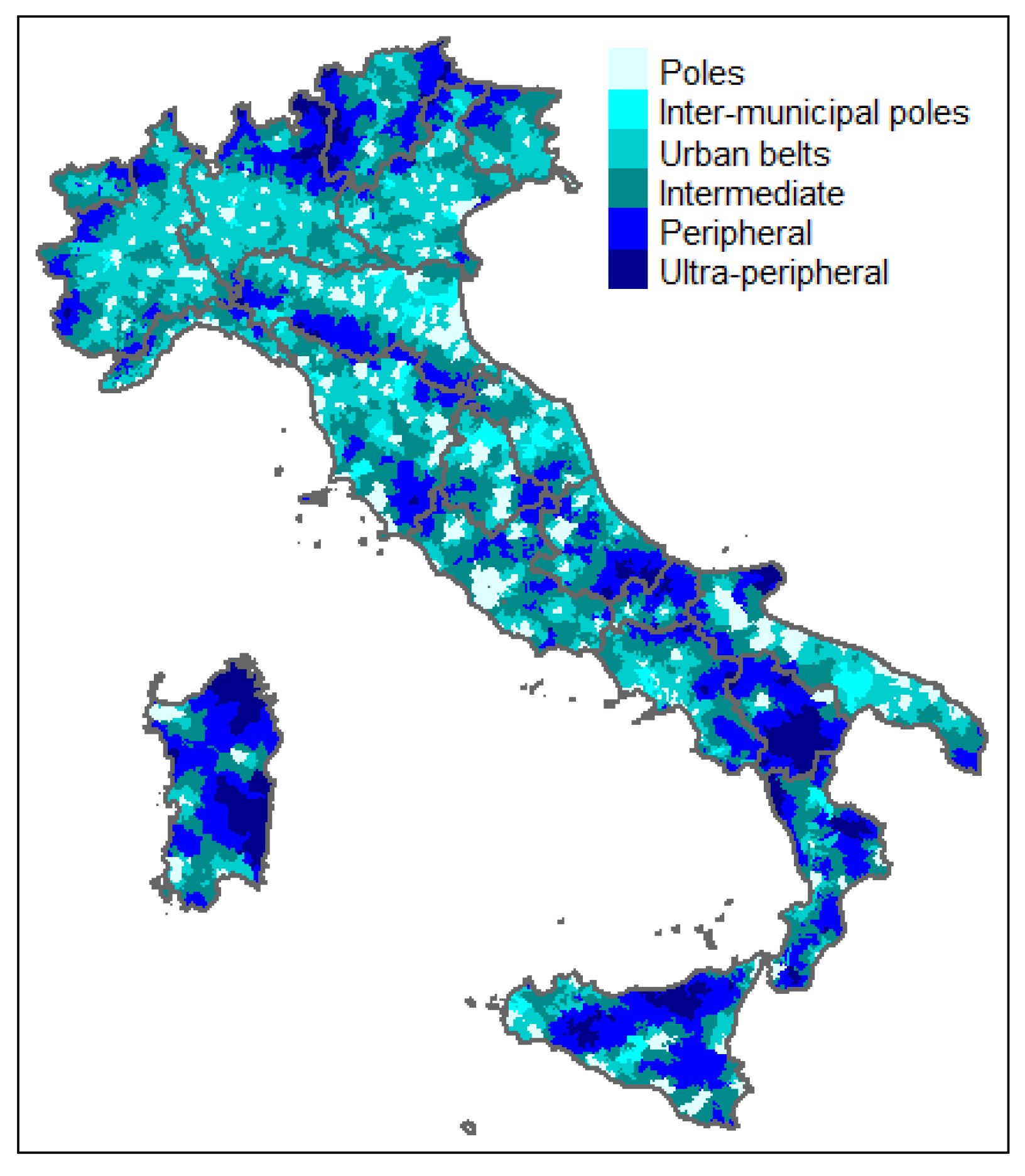
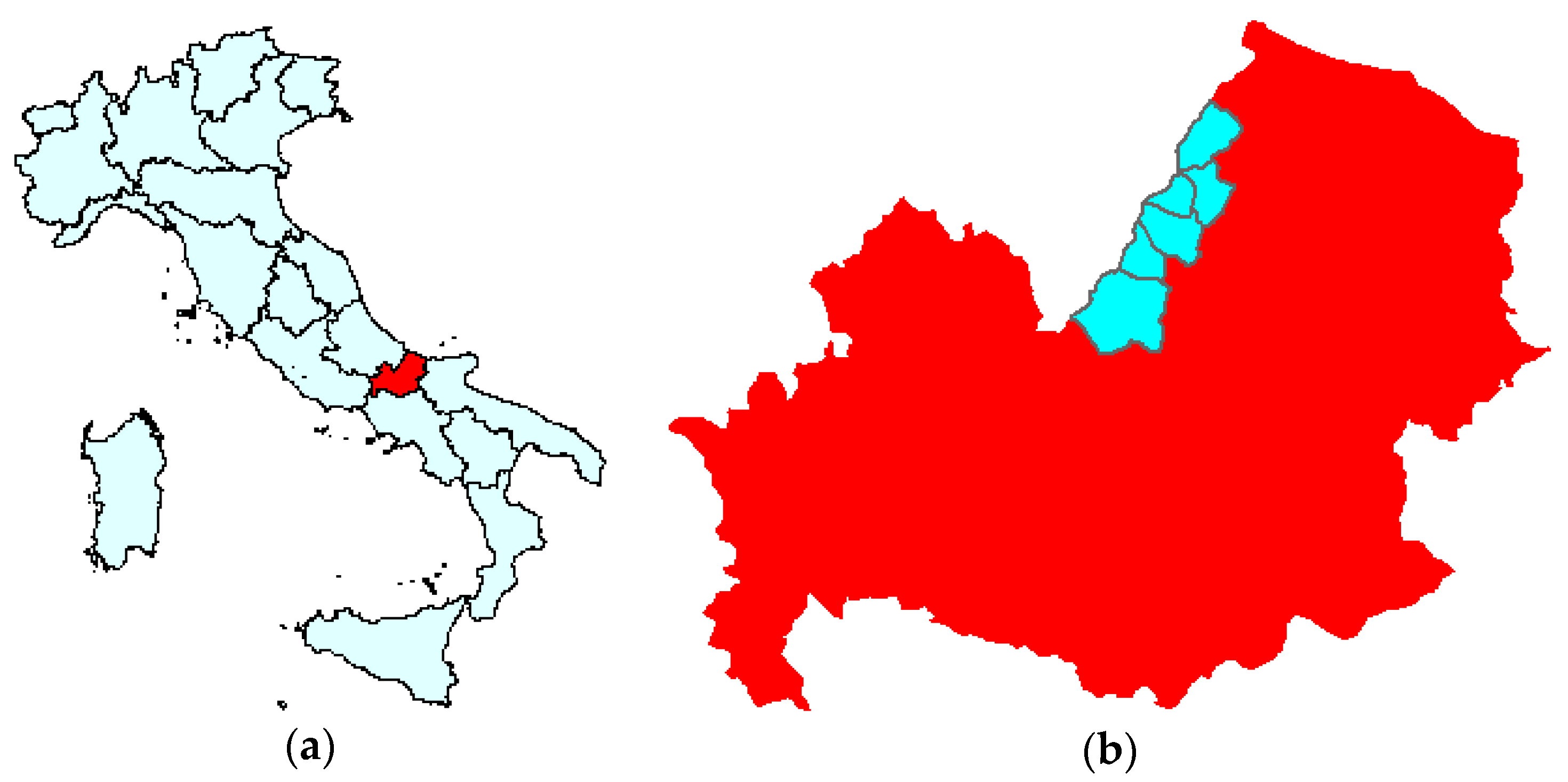


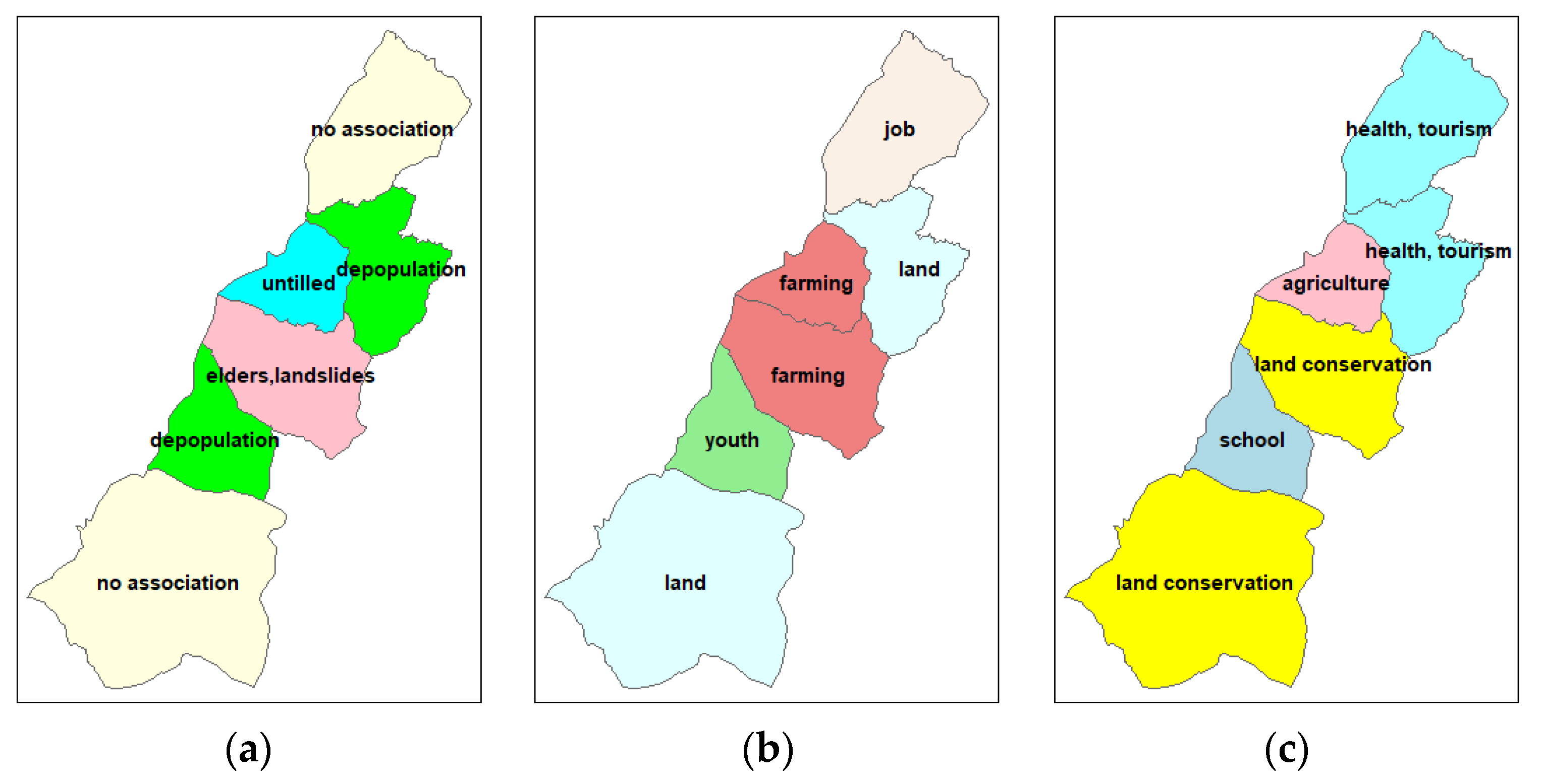
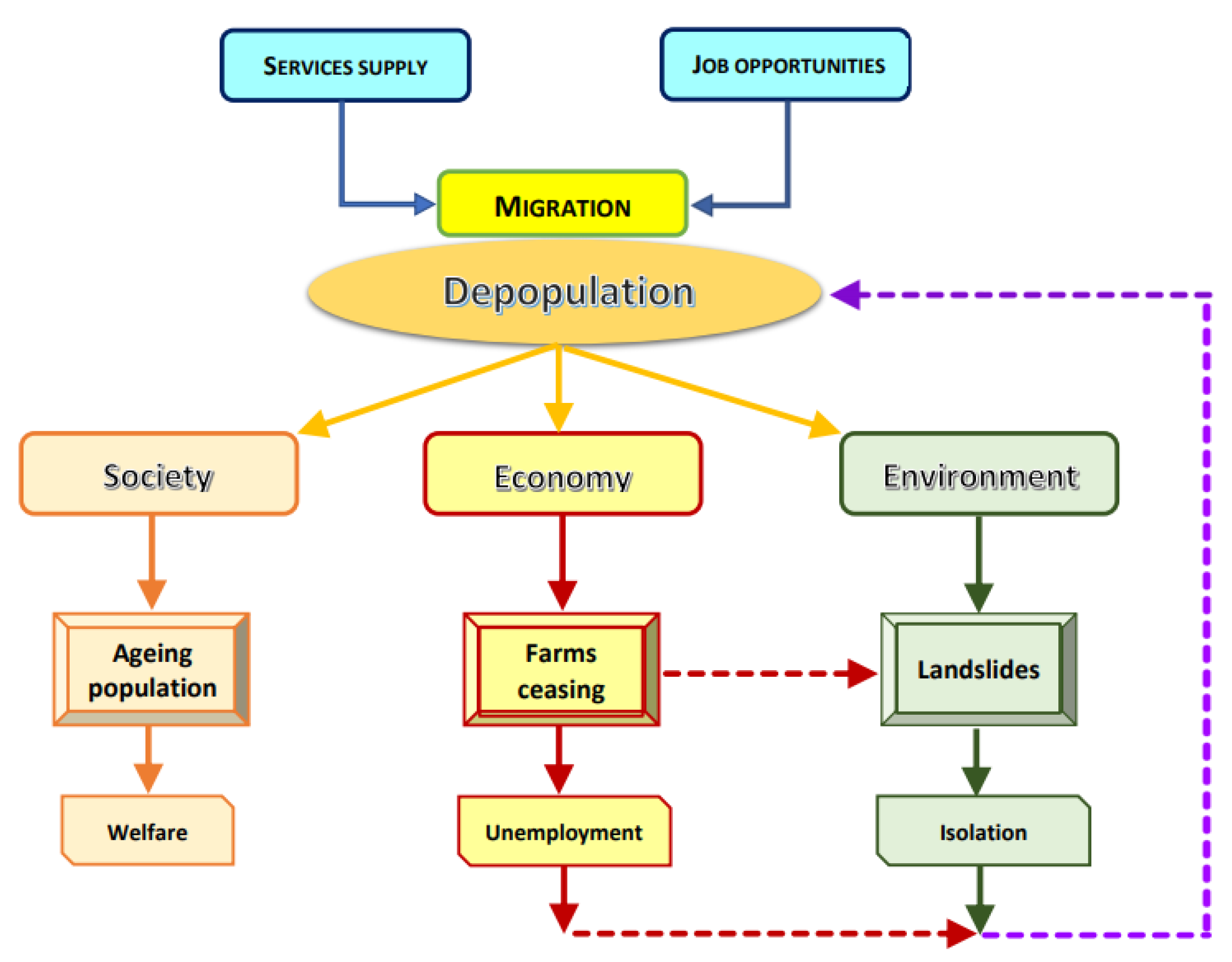
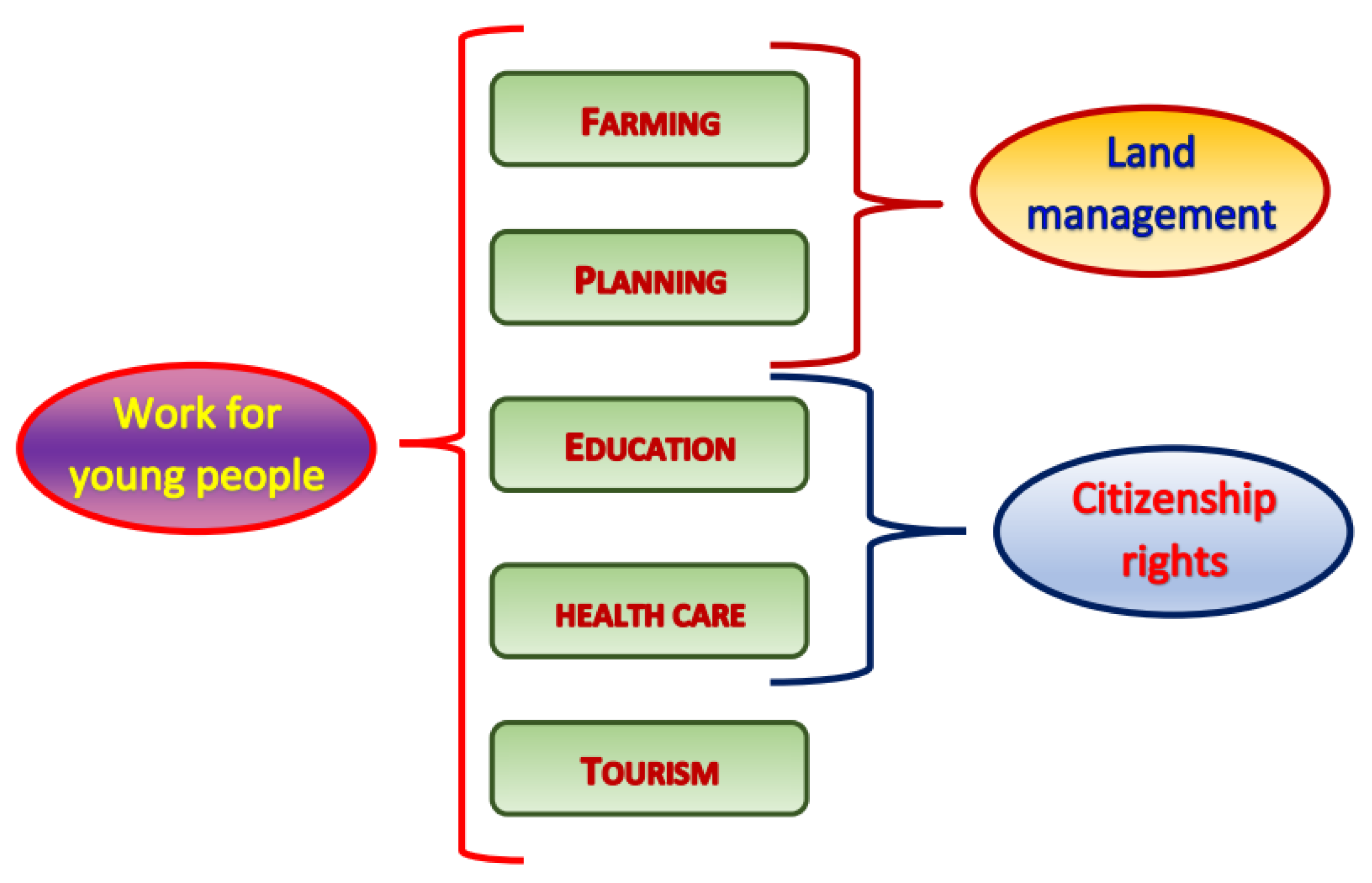
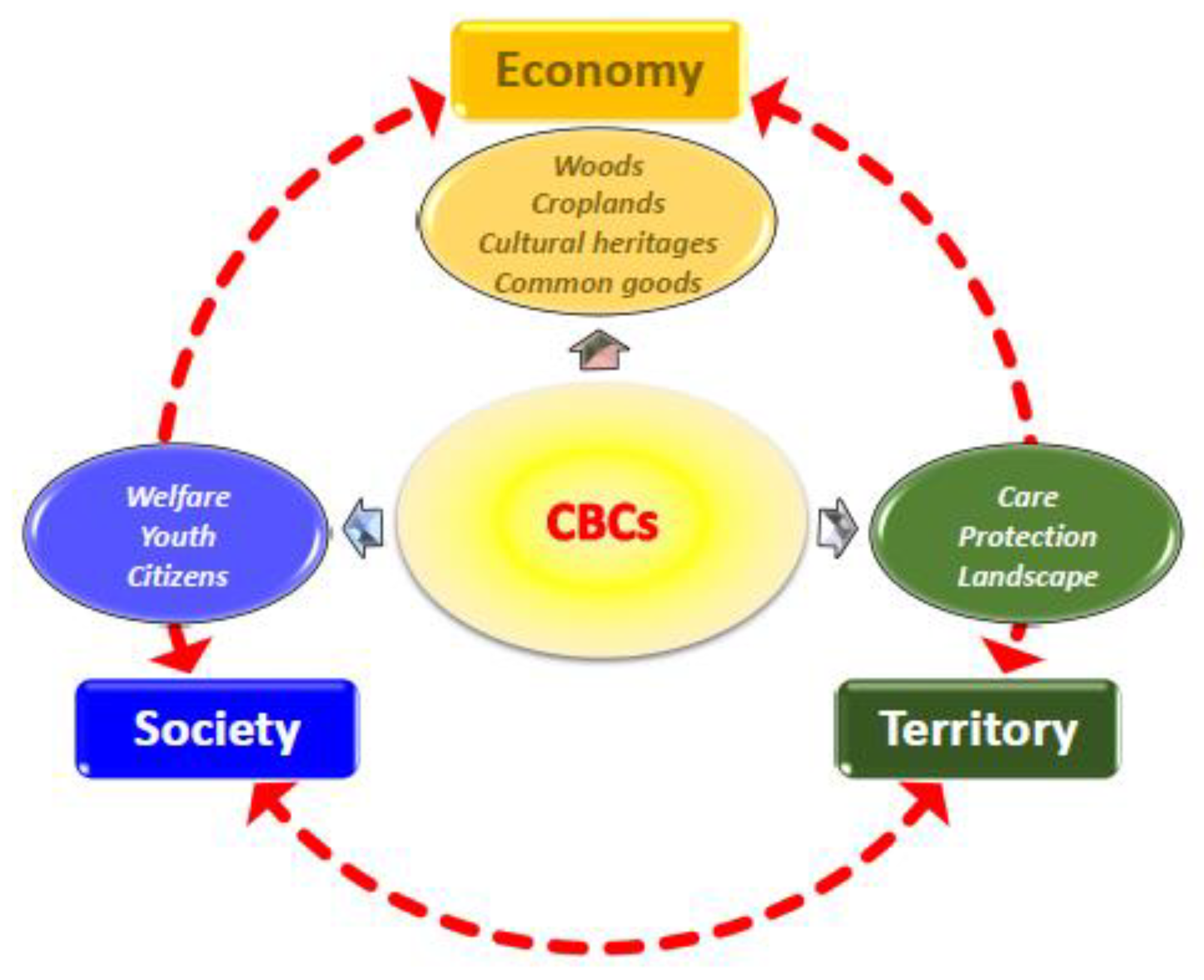
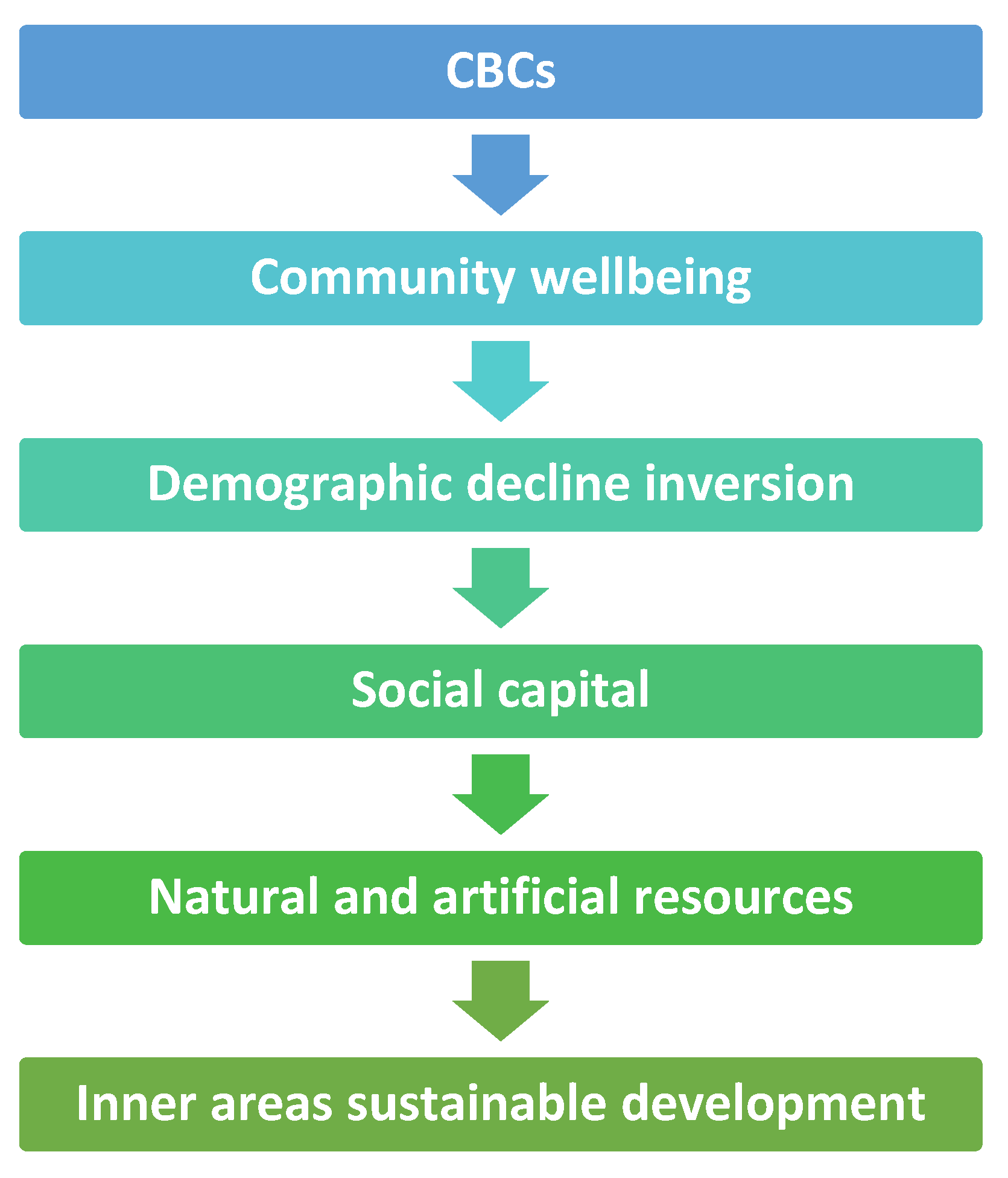
© 2020 by the authors. Licensee MDPI, Basel, Switzerland. This article is an open access article distributed under the terms and conditions of the Creative Commons Attribution (CC BY) license (http://creativecommons.org/licenses/by/4.0/).
Share and Cite
Mastronardi, L.; Romagnoli, L. Community-Based Cooperatives: A New Business Model for the Development of Italian Inner Areas. Sustainability 2020, 12, 2082. https://doi.org/10.3390/su12052082
Mastronardi L, Romagnoli L. Community-Based Cooperatives: A New Business Model for the Development of Italian Inner Areas. Sustainability. 2020; 12(5):2082. https://doi.org/10.3390/su12052082
Chicago/Turabian StyleMastronardi, Luigi, and Luca Romagnoli. 2020. "Community-Based Cooperatives: A New Business Model for the Development of Italian Inner Areas" Sustainability 12, no. 5: 2082. https://doi.org/10.3390/su12052082
APA StyleMastronardi, L., & Romagnoli, L. (2020). Community-Based Cooperatives: A New Business Model for the Development of Italian Inner Areas. Sustainability, 12(5), 2082. https://doi.org/10.3390/su12052082



